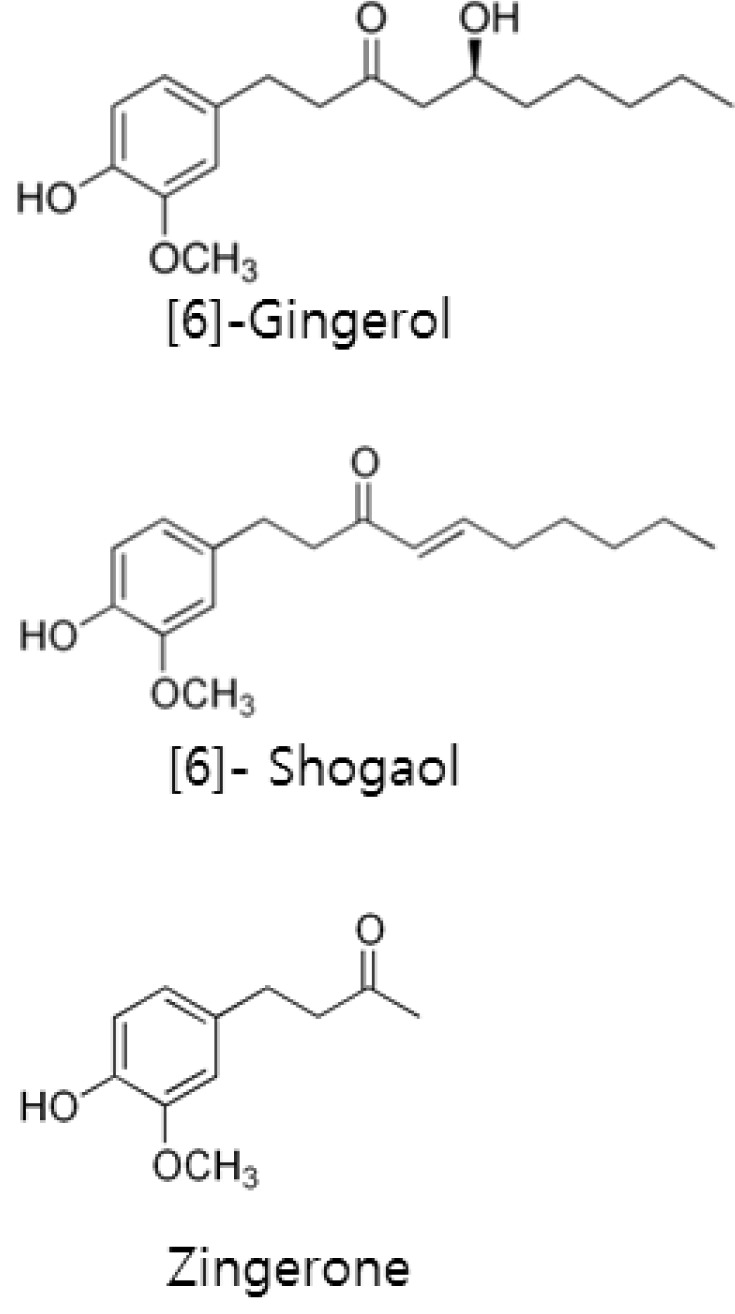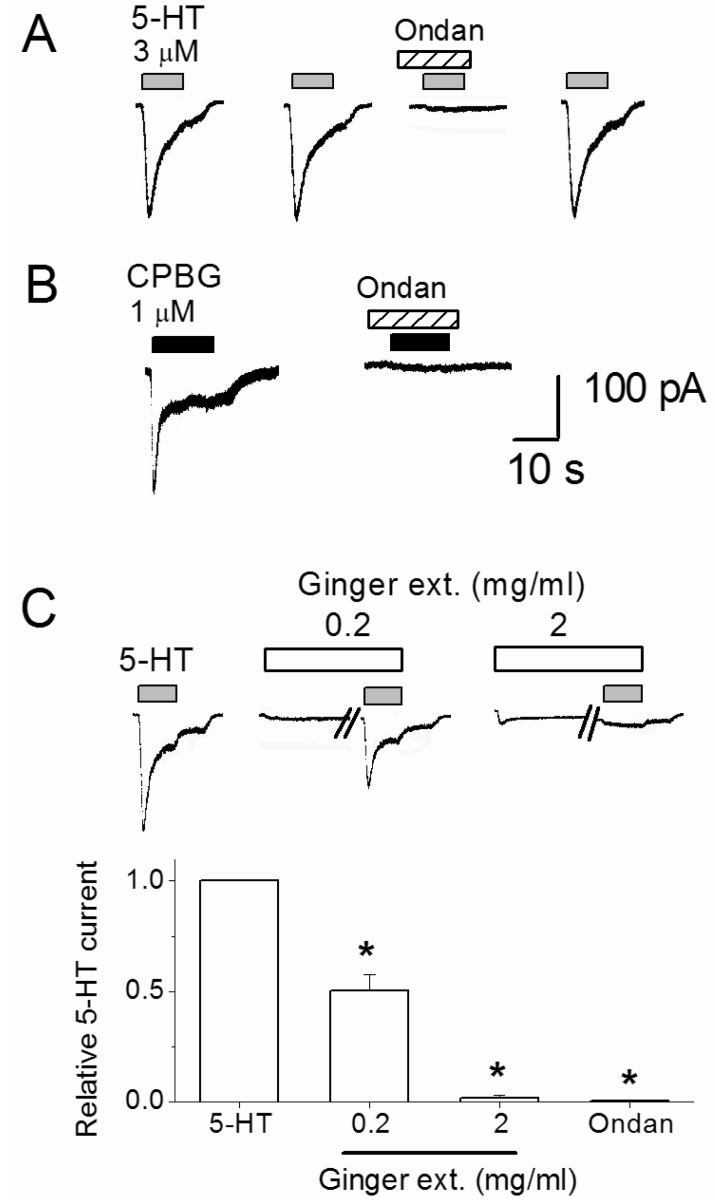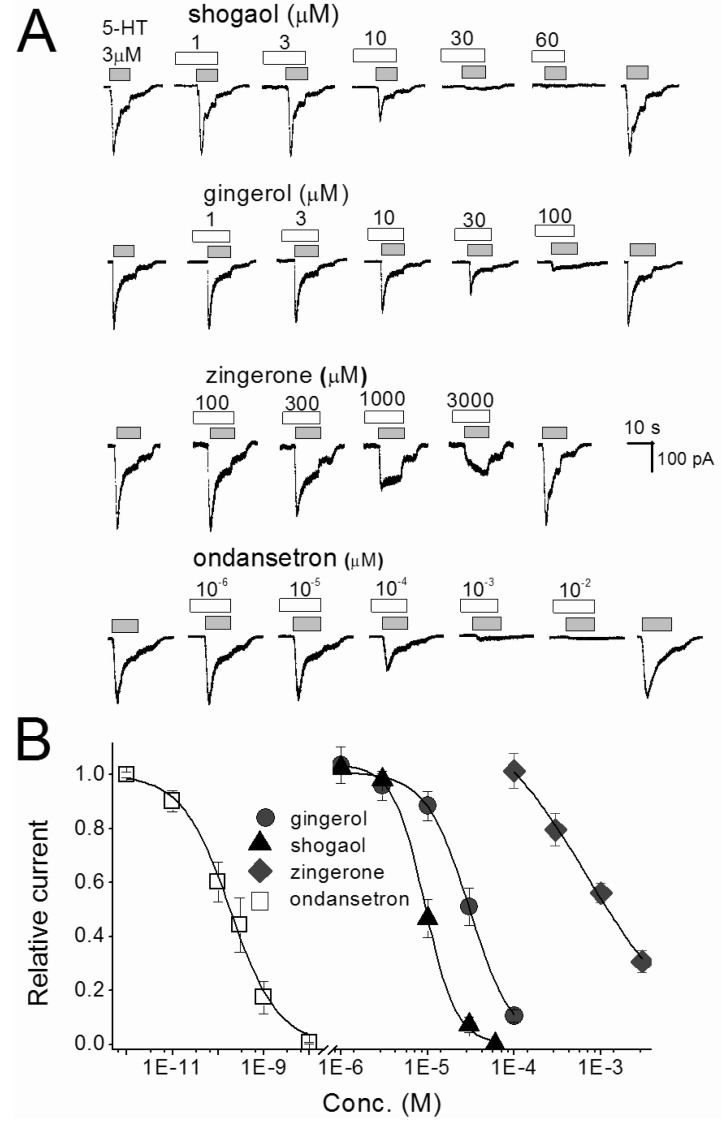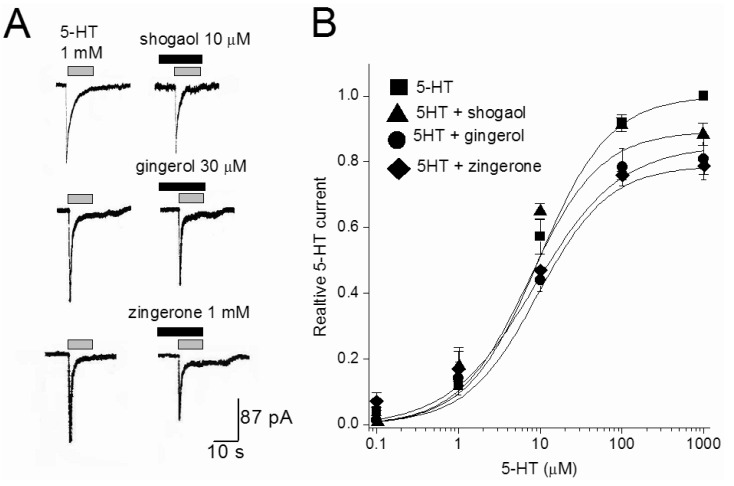Korean J Physiol Pharmacol.
2014 Apr;18(2):149-153. 10.4196/kjpp.2014.18.2.149.
Ginger and Its Pungent Constituents Non-Competitively Inhibit Serotonin Currents on Visceral Afferent Neurons
- Affiliations
-
- 1Department of Physiology, School of Medicine, Kyung Hee University, Seoul 130-701, Korea. jinyh@khu.ac.kr
- 2Department of Microbiology, School of Medicine, Kyung Hee University, Seoul 130-701, Korea.
- KMID: 2285504
- DOI: http://doi.org/10.4196/kjpp.2014.18.2.149
Abstract
- Nausea and emesis are a major side effect and obstacle for chemotherapy in cancer patients. Employ of antiemetic drugs help to suppress chemotherapy-induced emesis in some patients but not all patients. Ginger, an herbal medicine, has been traditionally used to treat various kinds of diseases including gastrointestinal symptoms. Ginger is effective in alleviating nausea and emesis, particularly, for cytotoxic chemotherapy drug-induced emesis. Ginger-mediated antiemetic effect has been attributed to its pungent constituents-mediated inhibition of serotonin (5-HT) receptor activity but its cellular mechanism of action is still unclear. Emetogenic chemotherapy drugs increase 5-HT concentration and activate visceral vagal afferent nerve activity. Thus, 5-HT mediated vagal afferent activation is essential to provoke emesis during chemotherapy. In this experiment, water extract of ginger and its three major pungent constituent's effect on 5-HT-evoked responses were tested on acutely dispersed visceral afferent neurons with patch-clamp methods. The ginger extract has similar effects to antiemetic drug ondansetron by blocking 5-HT-evoked responses. Pungent constituents of the ginger, [6]-shogaol, [6]-gingerol, and zingerone inhibited 5-HT responses in a dose dependent manner. The order of inhibitory potency for these compounds were [6]-shogaol>[6]-gingerol>zingerone. Unlike well-known competitive 5-HT3 receptor antagonist ondansetron, all tested ginger constituents acted as non-competitive antagonist. Our results imply that ginger and its pungent constituents exert antiemetic effects by blocking 5-HT-induced emetic signal transmission in vagal afferent neurons.
Keyword
MeSH Terms
Figure
Reference
-
1. Pillai AK, Sharma KK, Gupta YK, Bakhshi S. Anti-emetic effect of ginger powder versus placebo as an add-on therapy in children and young adults receiving high emetogenic chemotherapy. Pediatr Blood Cancer. 2011; 56:234–238. PMID: 20842754.
Article2. Ryan JL, Heckler CE, Roscoe JA, Dakhil SR, Kirshner J, Flynn PJ, Hickok JT, Morrow GR. Ginger (Zingiber officinale) reduces acute chemotherapy-induced nausea: a URCC CCOP study of 576 patients. Support Care Cancer. 2012; 20:1479–1489. PMID: 21818642.
Article3. Ali BH, Blunden G, Tanira MO, Nemmar A. Some phytochemical, pharmacological and toxicological properties of ginger (Zingiber officinale Roscoe): a review of recent research. Food Chem Toxicol. 2008; 46:409–420. PMID: 17950516.
Article4. Fischer-Rasmussen W, Kjaer SK, Dahl C, Asping U. Ginger treatment of hyperemesis gravidarum. Eur J Obstet Gynecol Reprod Biol. 1991; 38:19–24. PMID: 1988321.
Article5. Sharma SS, Kochupillai V, Gupta SK, Seth SD, Gupta YK. Antiemetic efficacy of ginger (Zingiber officinale) against cisplatin-induced emesis in dogs. J Ethnopharmacol. 1997; 57:93–96. PMID: 9254112.
Article6. Stewart JJ, Wood MJ, Wood CD, Mims ME. Effects of ginger on motion sickness susceptibility and gastric function. Pharmacology. 1991; 42:111–120. PMID: 2062873.
Article7. Horn CC, Richardson EJ, Andrews PL, Friedman MI. Differential effects on gastrointestinal and hepatic vagal afferent fibers in the rat by the anti-cancer agent cisplatin. Auton Neurosci. 2004; 115:74–81. PMID: 15507408.
Article8. Schwörer H, Racké K, Kilbinger H. Cisplatin increases the release of 5-hydroxytryptamine (5-HT) from the isolated vascularly perfused small intestine of the guinea-pig: involvement of 5-HT3 receptors. Naunyn Schmiedebergs Arch Pharmacol. 1991; 344:143–149. PMID: 1719432.9. Hawthorn J, Ostler KJ, Andrews PL. The role of the abdominal visceral innervation and 5-hydroxytryptamine M-receptors in vomiting induced by the cytotoxic drugs cyclophosphamide and cis-platin in the ferret. Q J Exp Physiol. 1988; 73:7–21. PMID: 3347698.10. Abdel-Aziz H, Nahrstedt A, Petereit F, Windeck T, Ploch M, Verspohl EJ. 5-HT3 receptor blocking activity of arylalkanes isolated from the rhizome of Zingiber officinale. Planta Med. 2005; 71:609–616. PMID: 16041645.11. Choi MJ, Jin Z, Park YS, Rhee YK, Jin YH. Transient receptor potential (TRP) A1 activated currents in TRPV1 and cholecystokinin-sensitive cranial visceral afferent neurons. Brain Res. 2011; 1383:36–42. PMID: 21316356.
Article12. Horn R, Marty A. Muscarinic activation of ionic currents measured by a new whole-cell recording method. J Gen Physiol. 1988; 92:145–159. PMID: 2459299.
Article13. Murase K, Ryu PD, Randic M. Excitatory and inhibitory amino acids and peptide-induced responses in acutely isolated rat spinal dorsal horn neurons. Neurosci Lett. 1989; 103:56–63. PMID: 2476693.
Article14. Lee BH, Choi SH, Hwang SH, Kim HJ, Lee JH, Nah SY. Resveratrol inhibits GABACρ receptor-mediated ion currents expressed in xenopus oocytes. Korean J Physiol Pharmacol. 2013; 17:175–180. PMID: 23626481.15. Yamahara J, Rong HQ, Naitoh Y, Kitani T, Fujimura H. Inhibition of cytotoxic drug-induced vomiting in suncus by a ginger constituent. J Ethnopharmacol. 1989; 27:353–355. PMID: 2615441.
Article16. Castejon AM, Paez X, Hernandez L, Cubeddu LX. Use of intravenous microdialysis to monitor changes in serotonin release and metabolism induced by cisplatin in cancer patients: comparative effects of granisetron and ondansetron. J Pharmacol Exp Ther. 1999; 291:960–966. PMID: 10565811.17. Mohan KC, Ravikumar K. Ondansetron hydrochloride: a competitive serotonin 5-HT3 receptor blocker. Acta Crystallogr C. 1995; 51:2627–2629. PMID: 8588861.
Article18. Abdel-Aziz H, Windeck T, Ploch M, Verspohl EJ. Mode of action of gingerols and shogaols on 5-HT3 receptors: binding studies, cation uptake by the receptor channel and contraction of isolated guinea-pig ileum. Eur J Pharmacol. 2006; 530:136–143. PMID: 16364290.
Article19. Walstab J, Krüger D, Stark T, Hofmann T, Demir IE, Ceyhan GO, Feistel B, Schemann M, Niesler B. Ginger and its pungent constituents non-competitively inhibit activation of human recombinant and native 5-HT3 receptors of enteric neurons. Neurogastroenterol Motil. 2013; 25:439–447. PMID: 23490018.
- Full Text Links
- Actions
-
Cited
- CITED
-
- Close
- Share
- Similar articles
-
- Electrophysiological properties of the neurons dissociated from the nucleus raphe magnus in postnatal rats
- Referred Pain
- Preparation and Evaluation of Anti-Emetic Ginger Orodispersible Tablets from Standardized Extract using Phenolic Profile Effects
- Effects of 5-Hydroxytryptamine on Potassium Currents of the Medial Vestibular Nuclear Neuron in the Rat
- Effects of Fluoxetine on Sodium Currents in Rat Sensory Neurons





